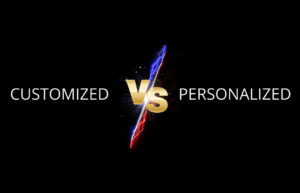Most people are familiar with the concept of customizing their ERP (Enterprise Resource Planning). However, few are familiar with the difference between customization and personalization (also called configuration), even though personalization can save companies thousands of dollars. In fact, personalization can save companies the value of their initial implementation costs when it comes time to upgrade their ERP. With so much money on the line, it is critical to ask: what’s the difference between customized and personalized ERP?
How ERP Customization Works
Although many think they understand what customization is, it is easy to confuse customization and personalization, but this will cost you down the line. A customization makes alterations to software source code. A customization is not inherently part of your ERP system, it will be unique to your solution, and it requires deep technical knowledge to execute correctly. Because customizations are unique and not included in your ERP out of the box, they are an added cost that can get expensive. Companies frequently look to a skilled ERP partner to develop customizations for them. At Datix, we can use our expertise as a one-stop shop to provide tailored customizations that support an organization’s competitive advantage. Even so, we usually recommend a client only complete essential customizations (and instead opt for personalizations) because of their associated costs and their potential problems down the line.
Problems with Customization
Customization can seem like the perfect solution to getting the exact ERP setup you want…until you need a software upgrade. Because customizations are just that, custom, they will break during ERP upgrades when the ERP vendor makes alterations to their software.
Additionally, a customization is only as good as the person who created it. If you hire an inexperienced ERP consultant to complete your customization and they do a poor job, then it is likely to be coded in a way that causes unexpected issues and requires frequent patches as time progresses.
Even if you hire a trustworthy ERP partner for your customization, there are inherent challenges with adding something unintended to your software and expecting it to continuously work as the system evolves. Your ERP vendor will likely provide periodic software updates throughout the year that could include security patches or even additional ERP modules if you are working with a great vendor. Whenever you update your system, even for something small, it has the potential to interfere with your customization and force you to scramble to fix the issue.
Upgrades are even more challenging and can cost the equivalent of the initial ERP implementation because of customizations. The expense of recreating customizations after an upgrade varies significantly depending on vendor and the nature of the upgrade. Upgrades that include core system modifications effectively erase any customizations that had worked with the old methodology.
How ERP Personalization Works
Personalizations (or configurations) allow you to alter your ERP system without customizing the system. Think about it this way: customization touches the base layer of software code. Personalizations are on a higher code layer so they are less likely to cause complications during upgrades.
The ERP vendor must design their system with the intention to allow for personalization and these changes can even be “low code or no code” setups. Because the ERP vendor considered personalization from the beginning, they design their ERP to maintain personalizations even after updates or upgrades.
Potential Cost Savings with Personalization
Naturally, personalization costs far less than customization, both in the short term and in the long term. Because personalization requires minimal or no coding compared to customizations, it costs far less to deploy initial. Unlike customization, personalization doesn’t break down after updating or upgrading your system, so you don’t need to pay to fix it whenever your software changes.
Does the ERP Vendor Matter for Customization and Personalization?
Yes! With some ERP vendors, even personalization can cause issues. For instance, when Epicor® changed their platform code base layer, all customizations and personalizations had to be completely recreated for their existing customers. This meant that the cost of the upgrade was equivalent to that of the initial implementation.
Epicor® ERP users may be facing a similar situation again. As the vendor transitions from having its user interface as an installed application to web-browser based setup, many personalizations and customizations will need to be completely recreated to work with the newer interface.
In contrast, Infor designed their platform to be conducive for personalization, meaning that your changes are not impacted by updates or upgrades. Because Infor designs its ERPs to allow for personalization, you save money upfront and in the long run because you don’t have to pay for customizing and fixing your customizations over and over.
With 25 years’ of experience, our team at Datix have experience with both Infor and Epicor® systems and can support tailoring either system (as well as other best-of-breed ERPs). That said, we highly recommend that organizations choosing an ERP for the first time consider a platform’s capacity to be personalized when selecting a system. Our team has expertise in six of the major best-of-breed platforms and can walk you through the advantages of each so you can find the best one for your business. Schedule a free consultation with one of our experts.
Wrap Up
Don’t customize your system thoughtlessly only to be blind sighted by costs to patch or completely recreate your customizations after an upgrade. Personalization is a viable solution for many companies looking to tailor their ERP without taking on unnecessary expenses or reducing the reliability of their system.
Talk to Datix about Tailoring Your ERP
About Datix
With over two decades in the industry, Datix is the ERP consultant of choice for manufacturers and distributors. We believe in “being the best with the best” and look for partners who match our commitment to solving real issues and doing what it takes. Our in-depth analysis of our clients and their business needs allows us to maximize their software investments to the fullest.


